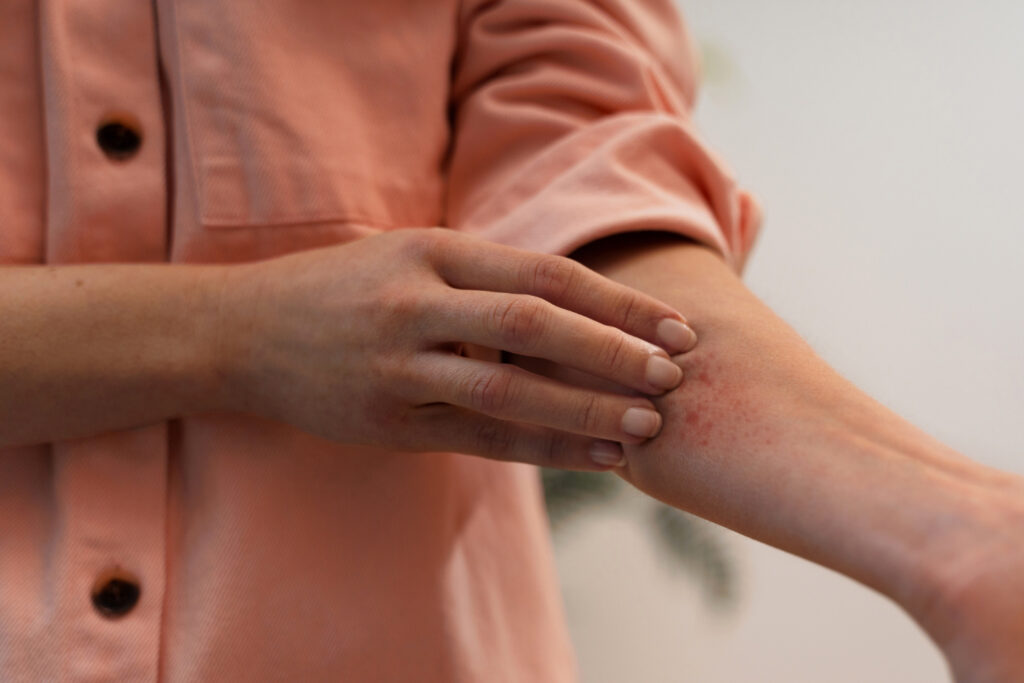
In this article
Heat rash, also known as prickly heat or miliaria, is a skin condition that manifests as patches or clusters of small, red bumps that are intensely itchy or cause a stinging sensation. This condition typically arises in hot, humid weather when sweat glands become blocked, trapping sweat under the skin. While anyone can develop heat rash, it is more common in babies and young children due to their underdeveloped sweat glands.
Most people notice heat rash within minutes to hours after sweating or spending time in a hot environment. It commonly appears on the neck, back, chest, thighs, and groin. Though uncomfortable, heat rash is not contagious and generally resolves within three days. Understanding the different types of heat rash and their symptoms can help you manage the condition and determine when to seek medical advice.
Common Symptoms of Heat Rash
Heat rash is categorized into four types, depending on which layer of the skin the sweat is trapped in. Despite differences in types, some common symptoms include:
- Clusters of tiny bumps on the skin
- Itchiness
- Redness and swelling
- Prickling, burning, or stinging sensations
Heat rash often develops on areas of the skin with a high concentration of sweat glands, such as the chest, back, armpits, neck, groin, and other skin folds.
Types of Heat Rash
1. Miliaria Crystallina
Miliaria crystallina is the mildest form of heat rash, occurring when sweat is trapped in the top layer of the skin. It is most common among newborns and adults who have recently moved to hot and humid areas. Symptoms include:
- Tiny, clear, fluid-filled blisters on the skin’s surface
- Blisters that rupture easily, usually without pain
Unlike other forms, miliaria crystallina is generally painless and does not cause intense itching or discomfort.
2. Miliaria Rubra (Prickly Heat)
Miliaria rubra is the most common form of heat rash, occurring when sweat is trapped deeper in the outer layers of the skin. It is prevalent in infants and adults living in humid climates. Symptoms typically include:
- Small, red bumps on the skin
- Intense itching or a prickling sensation
- Redness, discomfort, and inflammation around the bumps
- Lack of sweat near the rash
- Worsening symptoms with exposure to sunlight or humidity
3. Miliaria Pustulosa
Miliaria pustulosa is an advanced form of miliaria rubra, characterized by the formation of pus in the bumps. Symptoms include:
- Small, yellowish or white pustules on the skin
- Red, inflamed skin around the bumps
- Itchiness or tenderness in the affected area
Avoid scratching the bumps to prevent bursting and the risk of bacterial infection.
4. Miliaria Profunda
Miliaria profunda is the rarest and most severe form, occurring when sweat is trapped deep beneath the skin. It often develops in individuals with recurrent miliaria rubra. Symptoms, which typically appear on the chest, arms, and upper back, include:
- Large, raised, flesh-colored bumps
- Pain and discomfort in the affected area
- A rough, sandpaper-like feeling on the skin
- Fatigue due to decreased ability to sweat
Heat Rash in Infants and Children

Heat rash is common in infants and young children, especially during the summer or in hot, humid climates. Their underdeveloped sweat ducts make them more susceptible. Symptoms in children can appear on the neck, face, chest, arms, legs, and diaper area. Look for:
- Small, flesh-colored bumps on the skin
- Skin that is warm or tender to the touch
- Tiny fluid-filled blisters
- Increased irritability or fussiness due to itchiness or discomfort
When to Seek Medical Attention
Most heat rash cases resolve within three days without treatment. However, you should contact a healthcare provider if:
- Symptoms worsen or do not improve after three days
- There are signs of infection, such as pus, oozing, or fever
Seek urgent medical attention if you or your child experience symptoms of heat-related illness, such as:
- Fever
- Dizziness
- Nausea
- Rapid heart rate
- Difficulty breathing
Understanding the different types of heat rash and their symptoms can help you manage and treat the condition effectively
A Quick Review
Heat rash, or prickly heat, manifests as small red bumps that itch or sting, commonly occurring in hot and humid weather. It is especially prevalent among babies and young children. The condition usually clears up in three days. Understanding the types (Miliaria Crystallina, Miliaria Rubra, Miliaria Pustulosa, Miliaria Profunda) and symptoms can help manage and treat heat rash effectively. Seek medical advice if symptoms persist or worsen.











